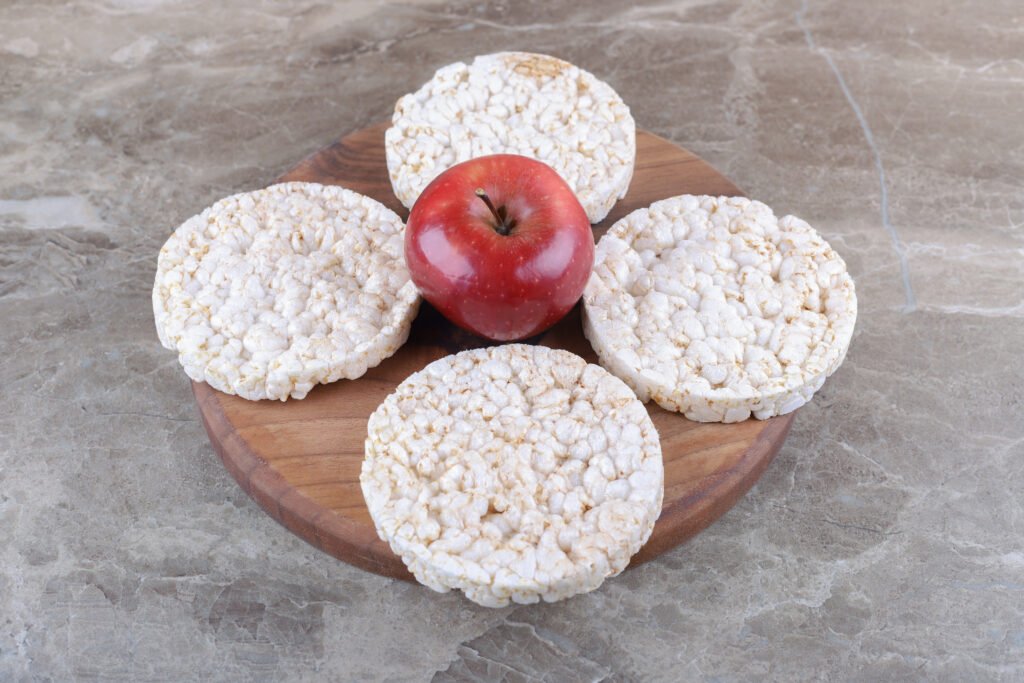
Treating and managing gastritis necessitates dietary adjustments and lifestyle changes, such as abstaining from alcohol and quitting smoking. Discipline and motivation are crucial in overcoming gastritis.
While effective treatment options exist, many find relief by complementing traditional approaches with natural remedies, including gastritis supplements.
Before attempting any home remedies, like applesauce for gastritis, consulting gastritis experts is essential, as individuals experience gastritis differently.
In this article, we’ll share expert gastritis diet tips on preparing applesauce for gastritis step by step. We’ll also explore the benefits of using gastritis supplements alongside, for sustainable and faster relief.
By following these expert recommendations, you can find relief from gastritis symptoms while promoting overall digestive health.
Let’s Begin With The Health Benefits And Importance of Gastritis-Friendly Diet
- Alleviating Symptoms
A gastritis-friendly diet can help alleviate symptoms such as stomach pain, bloating, nausea, and indigestion, providing relief to individuals suffering from gastritis.
- Supporting Healing
Certain foods included in a gastritis-friendly diet, such as fruits, vegetables, and lean proteins, can support the healing of the stomach lining, promoting faster recovery from gastritis flare-ups.
- Reducing Irritation
By avoiding foods that can irritate the stomach lining, such as spicy foods, acidic foods, and alcohol, a gastritis-friendly diet helps minimize inflammation and discomfort.
- Balancing pH Levels
Incorporating foods with alkaline properties, such as bananas and oatmeal, helps balance stomach pH levels, creating a more hospitable environment for healing.

- Preventing Aggravation
A gastritis-friendly diet aims to prevent further aggravation of the stomach lining, reducing the risk of complications such as ulcers or bleeding.
- Supporting Digestive Health
Foods rich in fiber, probiotics, and antioxidants, such as whole grains, yogurt, and leafy greens, support digestive health and contribute to overall well-being, which is crucial for managing gastritis.
- Improving Nutrient Absorption
By focusing on nutrient-dense foods that are easily digestible, a gastritis-friendly diet promotes optimal nutrient absorption, ensuring that the body receives essential vitamins and minerals necessary for healing and maintaining health.
Homemade Applesauce Recipe for gastritis

A. Ingredients Needed:
- Apples (preferably sweet and less acidic varieties like Gala, Fuji, or Golden Delicious) – 6 to 8 medium-sized
- Water – 1/2 cup
- Lemon juice (optional, for extra flavor and to prevent browning) – 1 to 2 tablespoons
- Cinnamon (optional, for added flavor) – 1/2 teaspoon
- Honey or maple syrup (optional, for sweetness) – to taste

B. Step-by-Step Preparation Instructions
- Wash and peel the apples. Remove the cores and cut them into chunks or slices.
- In a medium-sized saucepan, combine the apple chunks, water, and lemon juice (if using).
- Cover the saucepan and cook the apples over medium heat for about 15-20 minutes, or until they are soft and easily mashed with a fork.
- Once the apples are soft, remove the saucepan from the heat and let it cool slightly.
- Using a potato masher or fork, mash the cooked apples to your desired consistency. For a smoother applesauce, you can use a blender or food processor.
- If desired, add cinnamon and sweetener (honey or maple syrup) to the mashed applesauce and stir well to combine.
- Taste the applesauce and adjust the sweetness and flavor according to your preference.
- Transfer the applesauce to a clean jar or container and let it cool completely before refrigerating. Homemade applesauce can be stored in the refrigerator for up to one week.
C. Tips for Customization and Flavor Variations
- Experiment with different apple varieties to find the flavor and sweetness level you prefer.
- Add other fruits such as pear or berries for additional flavor and nutrients.
- For a thicker applesauce, cook the apples for a longer period of time and reduce the amount of water used.
- Adjust the amount of sweetener and spices according to your taste preferences.
- For a smoother texture, strain the applesauce through a fine mesh sieve after mashing.
- Get creative with flavor variations by adding ingredients like vanilla extract, nutmeg, ginger, or cloves.
- Make a larger batch of applesauce and freeze it in small portions for future use. Thaw in the refrigerator before serving.
What Is The Nutritional Content of Applesauce?
- Fiber
Applesauce contains soluble fiber, which can aid digestion and promote regular bowel movements, helping to alleviate constipation often associated with gastritis.
- Vitamin C
Applesauce is a good source of vitamin C, an antioxidant that supports immune function and helps reduce inflammation in the stomach lining.
- Potassium
Applesauce provides potassium, an electrolyte that helps regulate fluid balance in the body and may help neutralize excess stomach acid, reducing gastritis symptoms.
- Pectin
Applesauce contains pectin, a type of soluble fiber that forms a gel-like substance in the stomach, which can help soothe and protect the stomach lining from irritation.
- Low Acidity
Homemade applesauce typically has a lower acidity compared to whole apples, making it gentler on the stomach and less likely to trigger gastritis symptoms such as heartburn or acid reflux.
Potential Soothing Effects on the Stomach Lining
- Protective Properties
The natural compounds found in apples, such as pectin and quercetin, may have protective effects on the stomach lining, helping to reduce inflammation and promote healing in individuals with gastritis.
- Soothing and Cooling
The smooth texture of applesauce can provide a soothing and cooling sensation to the stomach, helping to alleviate symptoms such as pain, burning, and discomfort associated with gastritis flare-ups.
- Comfort Food
Applesauce is often considered a comfort food, and consuming it can have psychological benefits by providing a sense of comfort and satisfaction, which may contribute to overall well-being during gastritis flare-ups.
Pairing Applesauce With Other Gastritis-Friendly Foods

Pairing applesauce for gastritis with other gastritis-friendly foods can create delicious and soothing meals that are gentle on the stomach and promote digestive health.
Here are some ideas for pairing applesauce with complementary foods:
- Plain Yogurt
Mix applesauce into plain yogurt for a creamy and satisfying snack or breakfast option.
The combination of probiotics in yogurt and the soothing properties of applesauce can help promote a healthy gut environment and alleviate gastritis symptoms.
- Oatmeal
Add a dollop of applesauce to a bowl of warm oatmeal for a comforting and nourishing breakfast. Oatmeal is easy to digest and provides soluble fiber, while the applesauce adds natural sweetness and flavor without aggravating the stomach.
- Rice Cakes
Spread applesauce onto rice cakes for a light and crunchy snack that won’t irritate the stomach. Rice cakes are bland and easy to digest, making them an ideal base for topping with applesauce and other gastritis-friendly ingredients like banana slices or almond butter.
- Toast
Spread applesauce onto whole grain toast for a simple and satisfying snack or light meal. Whole grain toast provides fiber and nutrients, while the applesauce adds sweetness and moisture without adding acidity or spice.
- Baked Chicken
Use applesauce as a marinade or glaze for baked chicken for a flavorful and tender main dish. The natural sugars in the applesauce caramelize during baking, creating a deliciously sweet and savory coating that pairs well with lean protein.
- Steamed Vegetables
Serve applesauce alongside steamed vegetables like carrots, broccoli, or zucchini for a nutritious and balanced side dish.
The mild flavor and soft texture of steamed vegetables complement the sweetness and smoothness of the applesauce, creating a satisfying meal that is easy on the stomach.
- Cottage Cheese
Mix applesauce into cottage cheese for a creamy and protein-rich snack or light meal.
Cottage cheese is low in acidity and easy to digest, while the applesauce adds natural sweetness and flavor without the need for added sugar or artificial sweeteners.
Avoiding common triggers or additives
When using applesauce for gastritis relief, it’s essential to avoid common triggers or additives that can exacerbate symptoms or irritate the stomach lining.
Here are some tips for selecting and preparing gastritis-friendly applesauce:
- Check Labels
When purchasing store-bought applesauce, carefully read the ingredient list to avoid additives such as artificial colors, flavors, and preservatives. Opt for unsweetened or naturally sweetened varieties without added sugars or high fructose corn syrup.
- Choose Organic
Organic applesauce may be preferable as it is less likely to contain pesticides or other chemical residues that could potentially aggravate gastritis symptoms.
- Avoid Spices
Some commercial applesauce varieties may contain added spices such as cinnamon or nutmeg, which can be irritating to the stomach. Opt for plain applesauce or make your own at home without added spices.
- Steer Clear of High Acidity
Avoid applesauce made from tart apple varieties or those with added citric acid, as high acidity can trigger or worsen gastritis symptoms. Stick to sweet and less acidic apple varieties like Gala, Fuji, or Golden Delicious.
- Limit Sweeteners
While natural sweeteners like honey or maple syrup can enhance the flavor of applesauce, excessive sugar intake can exacerbate gastritis symptoms. Use sweeteners sparingly or choose unsweetened varieties if possible.
- Say No to Artificial Sweeteners
Avoid applesauce sweetened with artificial sweeteners such as aspartame or sucralose, as these additives may cause digestive discomfort or worsen gastritis symptoms in some individuals.
- Homemade is Best
Consider making homemade applesauce using fresh apples and minimal ingredients to ensure it’s free from additives and tailored to your taste preferences.
This allows you to control the sweetness and flavor without compromising on gastritis-friendly ingredients.
In conclusion
Managing gastritis through dietary adjustments is a proactive and effective approach to alleviate symptoms and promote healing of the stomach lining.
By adopting a gastritis-friendly diet, individuals can significantly reduce inflammation, discomfort, and the risk of complications associated with this condition.












